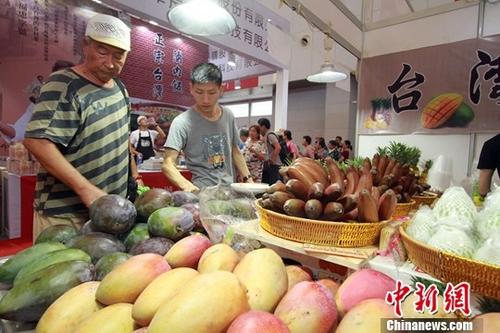The Growth of ASEAN Fruits in China: From "Luxury Goods" to "Explosive Prices"
Nanning, China News Service, July 22 nd Title: The Growth of ASEAN Fruits in China: From "Luxury Goods" to "Explosive Prices"
Author Zhong Jianshan Huang Cong

In the hot midsummer night, in the night market food street in Pingxiang, a border town between China and Vietnam, a small shop named "Hu Xishi Fruit Fishing" is the most lively scene. Diners from all over China queue up to buy a bowl of authentic Southeast Asian fruit fishing.
The clerk quickly diced fresh tropical fruits and put them in a transparent glass bowl, covered with corn kernels, red beans and shredded coconut, poured two spoonfuls of thick and fragrant condensed milk, and a bowl of refreshing and sweet fruit fishing can be served.
"Fruit fishing is a hot item in Pingxiang. The fruit is fresh and varied, and it tastes delicious and fragrant." Luo Zi, a frequent visitor to Hu Xishi’s fruit fishing shop, said that a bowl of fruit fishing brought together fruits from many countries in Southeast Asia was only sold in 10 yuan RMB, which was "too cost-effective".
Pingxiang is the most convenient land route from China to Viet Nam and even ASEAN countries, and has maintained the status of "China’s largest fruit import and export city" for five consecutive years. Every year, more than 1 million tons of fruits are imported and exported from Pingxiang Friendship Pass and Puzhai Port, with more than 500,000 tons of imported fruits. Every 500 grams of ASEAN fruits entering China are imported through Pingxiang.
"In the past, the cost of importing fruits from Southeast Asia to China was high, the cold chain logistics network was not perfect, and the border clearance time was long, which led to the high price of fruits in Southeast Asia in China." Chen Renqi, general manager of Guangxi Hongguihua Import and Export Trading Co., Ltd., said in an interview with a reporter from China News Service that his company has been engaged in the import trade of Vietnamese dragon fruit for 22 years, during which he witnessed the change of fruits in Southeast Asia from "luxury goods" to "explosive prices".
Chen Renqi said that because the pitaya with white fruit pulp has the advantage of low sugar, the early import of pitaya from Vietnam was mainly aimed at domestic diabetic patients and high-end consumers. With China — With the establishment of ASEAN Free Trade Area, China and ASEAN countries have strengthened cooperation in customs clearance and transportation interconnection, and a large number of fruits from Southeast Asia, such as pitaya, began to enter China. As the import cost is gradually decreasing, the sales price of pitaya in China is increasingly "close to the people", and it has entered the family recipes of ordinary people.
"In the past, Vietnamese dragon fruit had to enter China Port, and it took one day to go through various customs clearance procedures such as inspection and quarantine, and it took two or three days to go through, which was very costly. Now the customs clearance time has been reduced to one hour, which is too convenient. " Chen Renqi said that there is a great demand for fruits from Southeast Asia in the China market. Apart from traditional sales channels such as farmers’ markets and supermarkets, emerging industries such as chain juice shops, theme restaurants and fruit experience halls with tropical fruits from ASEAN as their main products have also developed rapidly, enriching the dietary choices of China consumers.
In Pingxiang City, new dishes of Chinese food mixed with ASEAN fruits such as stewed pork ribs with peaches, steamed pear, stewed chicken soup with grapes and fried beef with dragon fruit have become the "new favorites" of local people in recent years. Recently, the fruit specialty restaurant and fruit experience center in China Pingxiang, the first fruit city in ASEAN, officially opened its doors for guests. The local official plans to deeply integrate the fruit trade industry with the tourism industry, and make the one-stop shopping and special fruit meals of ASEAN special fruits a new highlight on the tourist route of Friendship Pass.
In order to meet the domestic market demand, Chen Renqi’s company has set up several directly affiliated factories and several agent factories in Vietnam. Among them, the factory directly under Panche City, Vietnam is the largest, which can produce 15 containers of pitaya every day. Every year, the company imports pitaya from Vietnam with a total value of 1.5 billion yuan, and fresh fruit is in short supply in China.
"We are exploring more kinds of fruit products and sales channels in Southeast Asia." Chen Renqi said that in addition to pitaya, Vietnamese red meat jackfruit has been welcomed by consumers in China in recent years, and the company has also started import business. In Cambodia, the price of local mango fresh fruit has a great advantage over that of China. The company invested 40 million yuan to set up a dried mango processing factory in Cambodia. The dried mango products were transported through Sihanoukville Port, passed through Ho Chi Minh Port in Vietnam to Qinzhou Port in China, and then distributed to all parts of China. At present, the annual output value of dried mangoes exceeds 50 million yuan.
Chen Renqi said that more and more China enterprises are joining the fruit industry in ASEAN, which means that the amount of ASEAN fruits entering the China market will continue to expand in the future. In the increasingly perfect environment of international agricultural cooperation and market competition, ASEAN fruit in China "will not increase its quantity, but its quality will be continuously optimized". (End)